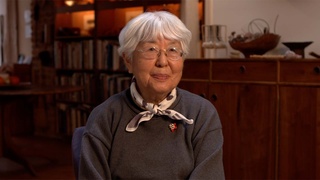Interviews
Anti-Japanese sentiment at the time of World War II
I*: Were you still in, at university when the war started?
Yes, I was at university when the war started, and at that time, at that time there was a lot of discrimination news in the papers, and usually it was from two politicians, and I guess it was because the Japanese didn't have the franchise in those days. One was Alderman Halford Wilson in the city council, and he was always saying something anti-Japanese, and the other was Howard Green, he was a conservative MP in Ottawa. And the reason I remember him 'cause he was a prominent United Church member and very prominent in the, in the news for the church things and the... then in the paper, he was always in the, saying something about the anti-Japanese in Ottawa in the parliament. But counteracting that, not many people, politicians spoke up for the Japanese, but there was a, when I was going to the university, there were a professor named Henry Angus, and he was, in his very thoughtful way, encouraged the students to ignore the anti-Japanese feelings in those days, and he really encouraged the Nisei students at university to, to go about their studies and try to not get too discouraged over the discrimination.
I: What do you remember about the start of the war? At the start of the war, I remember that we were all expected to go into the Canadian Officers' Training Corps at the universities, and we were all handed uniforms. And every, every... well, two or three times a week we went on marches and different exercises that we had to do, and did what we called some military training. There was a Colonel Shrum, he was a Physics professor, he was a colonel, and he was the head of the Canadian COTC training at the University of British Columbia.
*"I" indicates an interviewer (Teri Yamada).
Date: September 24, 2004
Location: Toronto, Canada
Interviewer: Teri Yamada
Contributed by: Sedai, the Japanese Canadian Legacy Project, Japanese Canadian Cultural Center
Explore More Videos

Feeling prejudice while looking for jobs
(1919 - 2015) Nisei who served in World War II with the 442nd Regimental Combat Team

Generosity of the Italians
(1919 - 2015) Nisei who served in World War II with the 442nd Regimental Combat Team

Invited to teach at Harvard by his boss
(1919 - 2015) Nisei who served in World War II with the 442nd Regimental Combat Team

Discrimination faced in San Francisco (Japanese)
(b. 1937) A war bride from Yokohama

The riot in Manzanar
(b. 1921) Nisei veteran who served in the occupation of Japan

The Dopey bank that survived the war
(b. 1934) Award-winning Disney animation artist who was incarcerated at Topaz during WWII

Accepted by Japanese society as I learned more Japanese (Japanese)
(b. 1979) Sansei Nikkei Brazilian who lives in Oizumi-machi in Gunma prefecture. He runs his own design studio.

Evacuated to the Jungle
(b. 1938) Philipines-born hikiagesha who later migrated to the United States.

Captured by Guerillas after bombing of Pearl Harbor
(b. 1938) Philipines-born hikiagesha who later migrated to the United States.

Grandfather picked up by US Army
(b. 1952) Former banking executive, born in Hawaii

Father's business partner operated their farming business during WWII
(b. 1935) Sansei businessman.

Father was convinced the constitution would protect him
(b. 1935) Sansei businessman.


The lack of discussion about family’s incarceration in Amache
Sansei judge for the Superior Court of Los Angeles County in California

